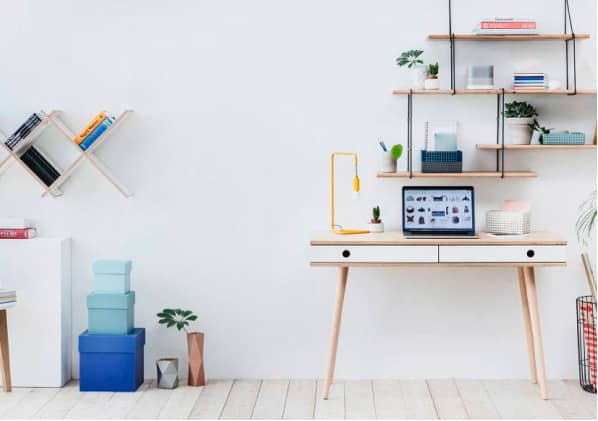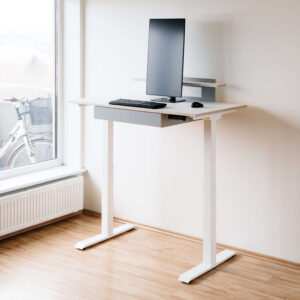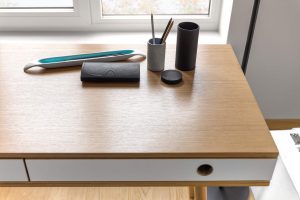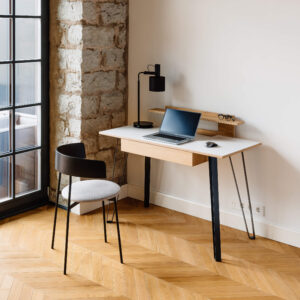As many of us know, home offices have been our latest focusing subjects and Radis Furniture has launched many collections that are giving an opportunity to enhance working manifests in our reachable spaces in-home or away.
Anne Vingisar knows a definitive material right down to the tiniest scratch. And as an architect alumna from the Arts Academy in Tallinn, she started her career with projects like a pavilion Spectrum for Gwangju FollyIII (South Korea 2016), Department store at Tallinn (2017), National Broadcasting house project (2019), Finnish National Museum extension project (2019), she can’t resist exhibition space or fabulous furnishing design projects and we don’t have any problem with that. As we also can’t resist a twist, we feature also product designer Merike Liiva for separate stages, who has a strong bond into the hands-on matter. Her previous projects include case studies on cult branding, how to heal stigma around depression, psychological support platforms, dish set for Melbourne cafe and plywood pendant light to take minimum packaging space because sometimes shipping a product is even more expensive than itself. Both power forces interviewed by Maris Vahter from Radis Furniture.

Architect Anne Vingisar and product designer Merike Liiva © private collection
Maris: About enhancing a work spot at home. It has been for some a full year now with “working from home” mode on. Any tips to get this to the next level. What issues and directions should lead us to the future?
Anne: Enhancing a workspace means enhancing the home! In the moment of being homebound, we need our interior spaces to be flexible to accommodate the various temporary activities throughout the day. Most importantly we need to enjoy the space regardless of the function it holds at that moment. A space that feels safe – where you see honest materials (quality and naturality), you own not too many things so you don’t get mentally overwhelmed and mindfully bought furniture that helps to transform the function of the space.
People will value their homes more than before, and aim to make spaces more functional and fluid in their purposes. Underutilized spaces are now being used in different ways, from foyers being transitioned into temporary offices to garages becoming spaces for movie nights.
The new home office is a multifunctional space or often a series of multifunctional spaces throughout a house or an apartment. Accommodating family members work or study in different parts of the rooms by temporary separation with curtains, glass walls or wooden ribs Room separators help to open and close off space accordingly – making it easier to fluctuate between private and public depending on the nature of the work task in hand. This could be done also with furniture, moving it in accordance with the daily rhythm and social connectivity or closeness at the time of focus.
I admire how in incredibly dense countries they’ve managed to protect concepts of privacy and individual space and sensitivity to the relationship between the individual and the family. Managing usually in a very small amount of space through very carefully layered design from private to public. A transformable space will be the future and when we think about it at the same time has always been an essential way to fulfil the spatial human needs. The pandemic has caused a change in how we live, work, and recreate and has brought a renewed focus on function and flexibility on top of aesthetics and luxury in this new normality. Simply said a home shouldn’t look like an office when it’s not being used as a workspace.
Merike: Create yourself a work corner where you only do work, don´t spread your workspace across the home. Otherwise, it will be difficult to turn yourself on and off work. Take your work to the next level by learning about deep work and practising it.
Height adjustable desk VISTA © Radis Furniture
Maris: When to start, when to finish a day, how to fill it with freshness and what about little details and workout to stay motivated. What to do when a family has children and they need to do same time video lessons as you do zoom with clients. Advice corner here – designated workspaces for everyone!
Anne: As we shelter in place, the rooms where we once spent few waking hours now encapsulate our entire existence—and this short-term recalibration may have a long-term effect on our well-being. I think that it is so important to know your work and life patterns and translate that into your physical living space. To subordinate your home to your routine and individual and family rhythm. the analysis of home space helps to choose knowingly work and leisure spaces in accordance with your life rhythm – if you are productive in the morning then it’s best to transform the east-facing window room into Office for the morning. Even if it is a bedroom where you can wall-mount a small desk for the computer and close the bed off with a curtain (back-drop for meeting calls). Or if you accumulate energy from the evening sun then transform the west-looking window room into a workspace. If you need the evenings for relaxation and book reading, use it to your advantage. The key is to find a rhythm according to natural daylight movement and your own rhythm of 8 hours of sleep, 8 hours of work and 8 hours for necessities as described by psychologists. One of the most motivating ways to start a workday is either with a quick workout to feel accomplished right away or by first tackling the worst and most important task of the workday.
For the balance, it is important to commercialize work, school and life into boxes or cabinets that you can mentally and physically put out of sight when the workday is over. The line of thought tends to be manipulated by visuals – visual creatures tend to subconsciously think about what they see. Don’t leave the workspace visually pulling you into it after the work hours – as it will pull apart the routine and personal rhythm. Put the task at hand in a box at the end of the day – workday, work role and worries – symbolically and physically.
The importance of storage will increase as people seek more ways to cleverly conceal personal and household items to transform a home into an office and vice versa. At the moment we are learning how important the organization of our space is in promoting productivity. Less about aesthetics and more about fewer things to own and therefore to put away and by decluttering creating more space for flexible functions.
Merike: Back in the good old days we used to commute to work and out of it, now we just have to fake it for ourselves. Create clear work hours and morning routine which gives you a signal that it´s time to get to work. For me, it is a morning walk, workout and reading a book before work. The same goes for the end of the work routine. Work never ends but your brain needs to rest and shut down from work mode, so create a routine that gives you a signal that it is time to shut your laptop and relax. Do something fun and active after work, so you can´t think about your next task the whole night.
Oak veneered desk MAN © Radis Furniture
Maris: Major visionaries are shut or talking. What do they say? What changes in architecture and how we should implement new era space around us during lockdowns?
Anne: Visionaries talk but it’s important to learn from the first-hand experience for us all, how important is our now multifunctional space, how it moulds us – our mood, productivity, view of the world – depending on light, view, ceiling height, openness or closeness of the space, contrasting displays or monotonousness.
I think it’s important that people of all fields speak up about their home space and urban space quality (urban spaces are our collective living rooms). If the majority of people analyze and communicate the essence and quality of good living space, we could evolve our private and urban spaces by common demand. Being confined in space helps us to drill into its qualities- better quality increases our well-being. I hope that with this experience we will learn to read the language of architecture as a society and better our environment that in return shapes us. And that we learn to read the language of landscape architecture that has such an important essence in the important role of public space.
Merike: Honestly, I don’t know but however I hope that open offices will eventually disappear.
Maris: Thank you both Anne and Merike for filling the emotional borderline territory of current transmission between now and the old normality.
Home office with VISTA desk © Radis Furniture




